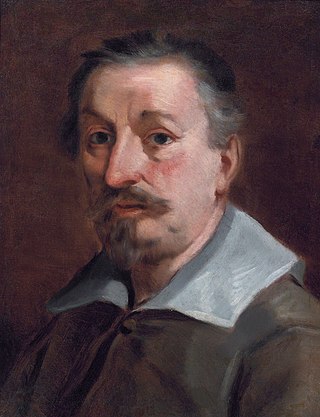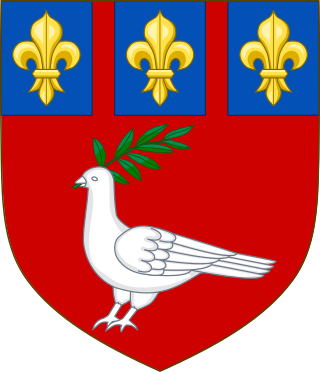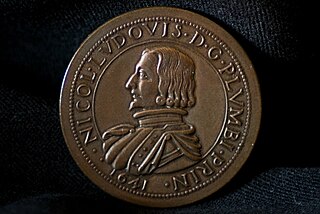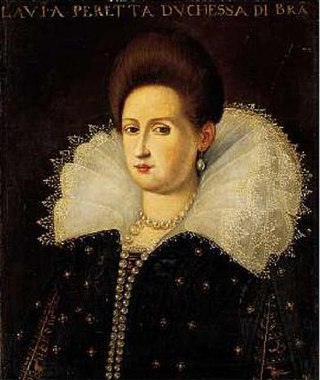
The House of Borghese is a family of Italian noble and papal background, originating as the Borghese or Borghesi in Siena, where they came to prominence in the 13th century and held offices under the commune. During the 16th century, the head of the family, Marcantonio, moved to Rome, where they rose in power and wealth following the election of his son Camillo as Pope Paul V in 1605. They were one of the leading families of the black nobility and maintain close ties to the Vatican.

Francesco Albani or Albano was an Italian Baroque painter of Albanian origin who was active in Bologna, Rome, Viterbo (1609–1610), Mantua (1621–1622) and Florence (1633).

Ranuccio I Farnese reigned as Duke of Parma, Piacenza and Castro from 1592. A firm believer in absolute monarchy, Ranuccio, in 1594, centralised the administration of Parma and Piacenza, thus rescinding the nobles' hitherto vast prerogative.

The House of Aldobrandini is an Italian noble family originally from Florence, where in the Middle Ages they held the most important municipal offices. Now the Aldobrandini are resident in Rome, with close ties to the Vatican.

The House of Pamphili was one of the papal families deeply entrenched in Catholic Church, Roman and Italian politics of the 16th and 17th centuries.
Ludovico Chigi della Rovere-Albani was Prince and Grand Master of the Sovereign Military Order of Malta from 1931 to 1951.

Ippolito Aldobrandini was a Catholic Cardinal. Pope Clement VIII, whose birth name was also Ippolito Aldobrandini, was his great-uncle.

The Diocese of Frascati is a Latin suburbicarian see of the Diocese of Rome and a diocese of the Catholic Church in Italy, based at Frascati, near Rome. The bishop of Frascati is a Cardinal Bishop; from the Latin name of the area, the bishop has also been called Bishop of Tusculum. Tusculum was destroyed in 1191. The bishopric moved from Tusculum to Frascati, a nearby town which is first mentioned in the pontificate of Pope Leo IV. Until 1962, the Cardinal-Bishop was concurrently the diocesan bishop of the see. Pope John XXIII removed the Cardinal Bishops from any actual responsibility in their suburbicarian dioceses and made the title purely honorific.

Don Giacomo I Boncompagni was an Italian feudal lord of the 16th century, the illegitimate son of Pope Gregory XIII. He was also Duke of Sora, Aquino, Arce and Arpino, and Marquess of Vignola.

Niccolò I Ludovisi, 2nd Duke of Fiano and Zagarolo, was Prince of Piombino, Marquis of Populonia, Prince of Venosa and Count of Conza, Lord di Scarlino, Populonia, Vignale, Abbadia del Fango, Suvereto, Buriano, Cerboli e Palmaiolan, and Lord prince of the Tuscan Archipelago including the islands of Elba, Montecristo, Pianosa, Gorgona, Capraia, and Isola del Giglio from 1634 until his death.

Olimpia Aldobrandini was rich and powerfull Italian noblewoman. By birth, she was member of an old and influential Aldobrandini family of Rome, and the sole heiress to the great family fortune.
Paolo Borghese (1622/24–1646) was an Italian nobleman of the Borghese family. He was the son of Marcantonio II Borghese (1598–1658) and his wife Camilla Orsini.

Camillo Francesco Maria Pamphili, 1st Prince of San Martino al Cimino and Valmontone was an Italian Catholic cardinal and nobleman of the Pamphili family. His name is often spelled with the final long i orthography; Pamphilj.

Cinzio Passeri-Aldobrandini was an Italian cardinal.
Orazio Ludovisi was an Italian nobleman, military commander and patrician of Bologna. During his brother's reign as Pope Gregory XV, he became Commander of the Papal Armies, Roman Noble and 1st Duke of Fiano and Zagarolo.

Margherita Aldobrandini, was an Italian noblewoman member of the Aldobrandini family and by marriage Duchess consort of Parma and Piacenza during 1600–1622. She was also Regent of both Duchies during 1626–1628 on behalf of her minor son.
Giovanni Aldobrandini was an Italian Roman Catholic bishop and cardinal.

Francesco Sforza was an Italian cardinal and bishop. He was very influential in a number of conclaves.

The Cesi family is an Italian noble family which belonged to the high aristocracy of Rome and the Papal States.

Flavia Damasceni Peretti, Duchess of Bracciano was an Italian noblewoman, niece of Pope Sixtus V and duchess consort of Bracciano as wife of Virginio Orsini. She is also known as the patroness of several poets, writers and musicians.















